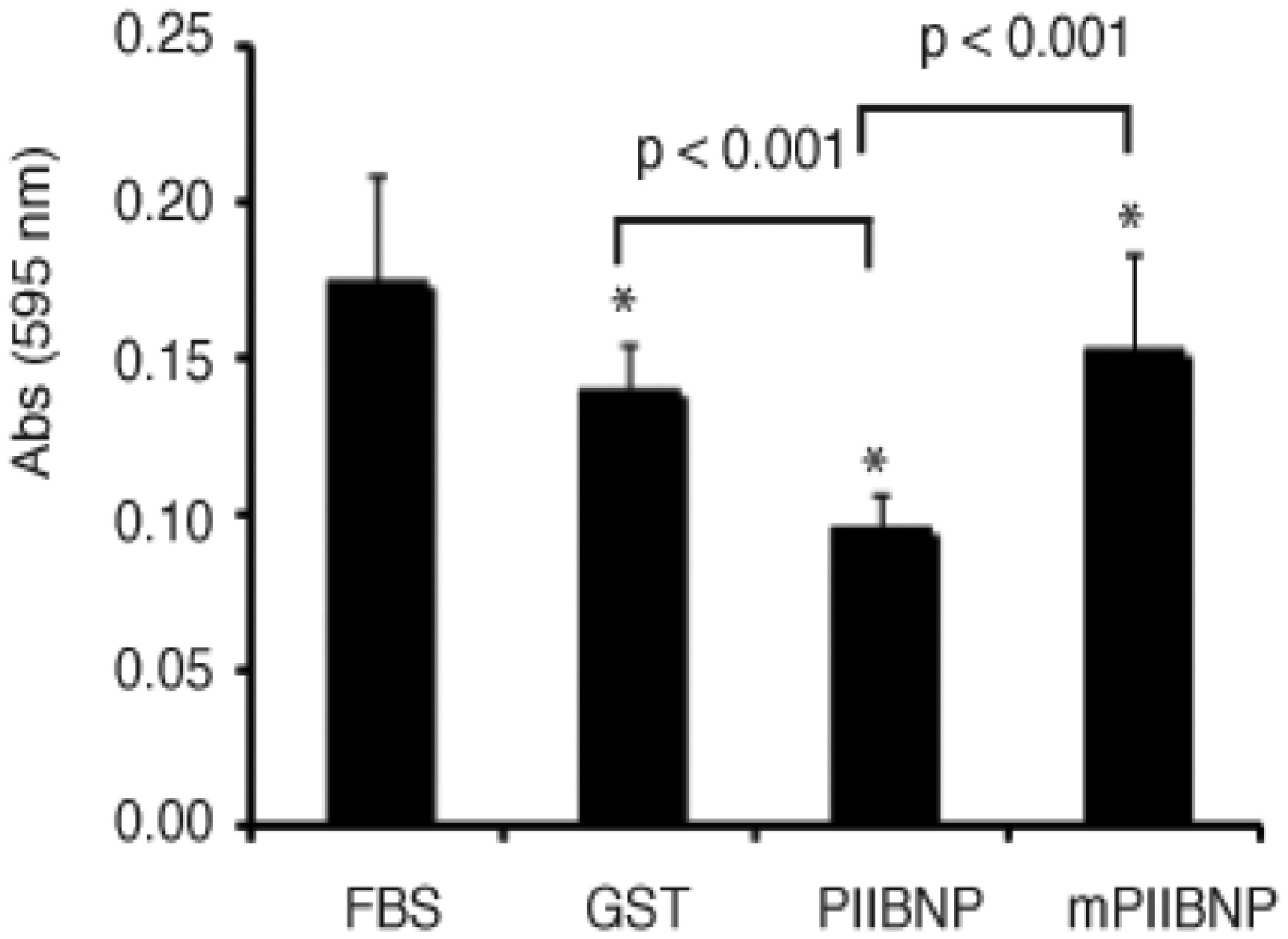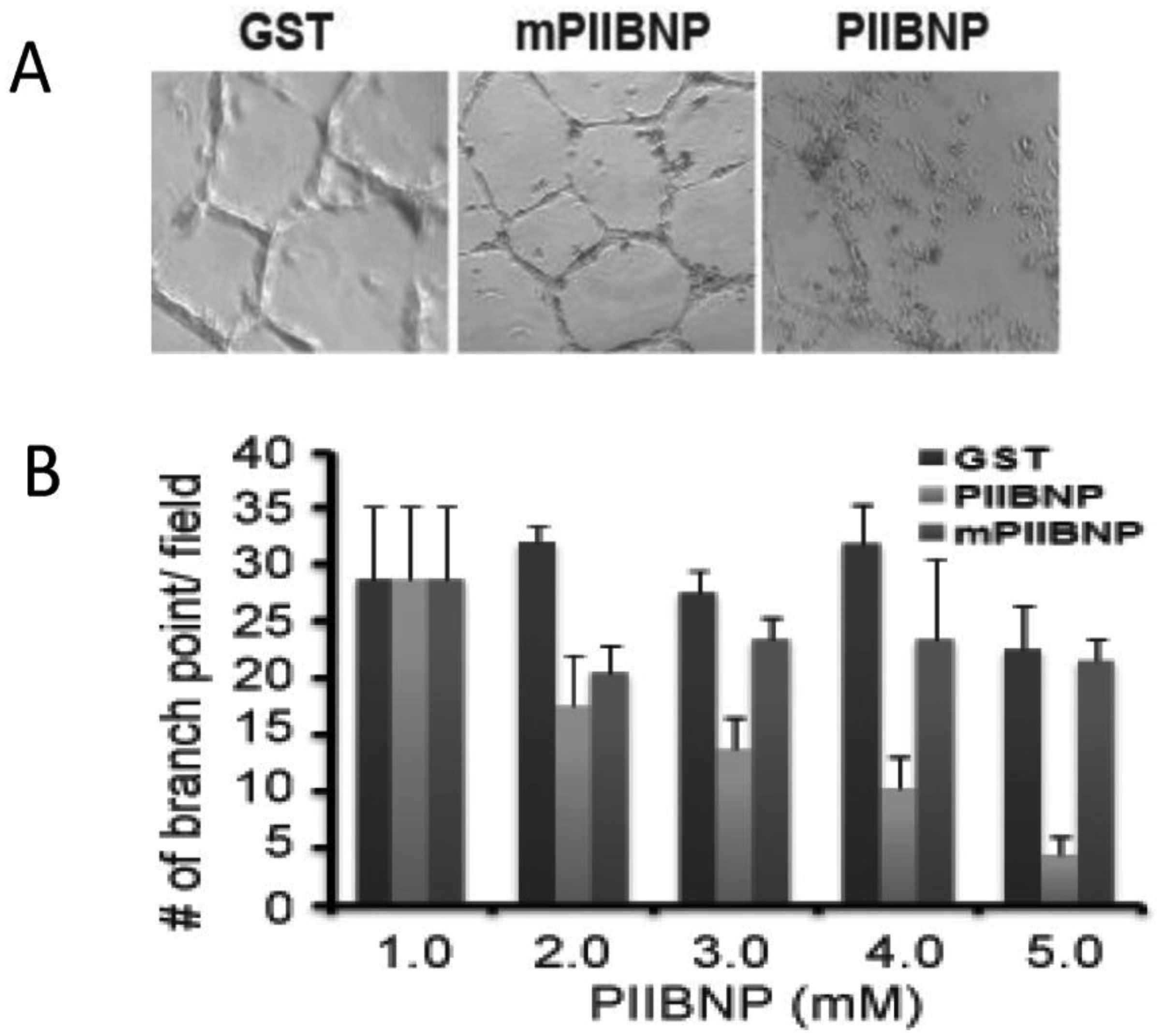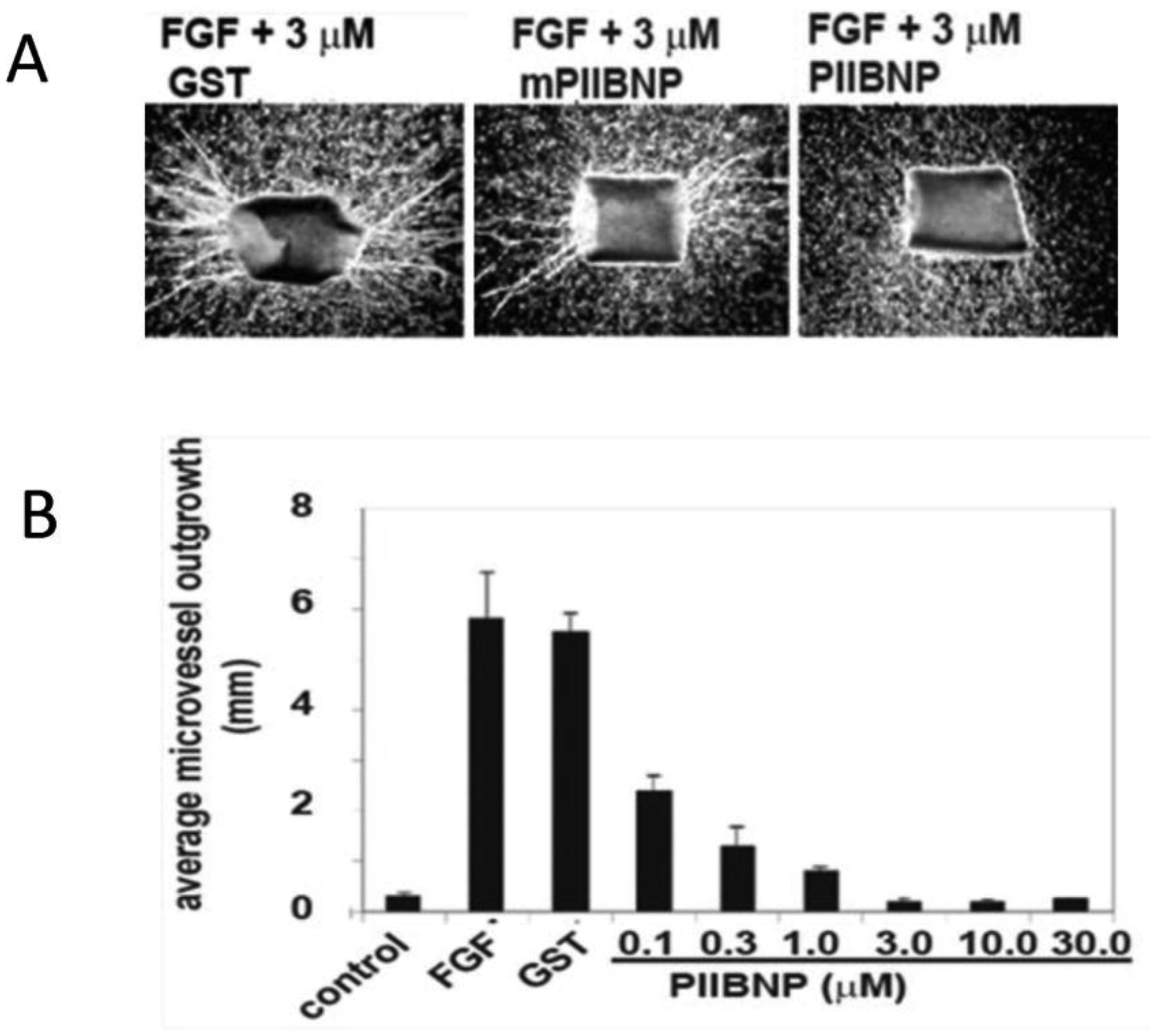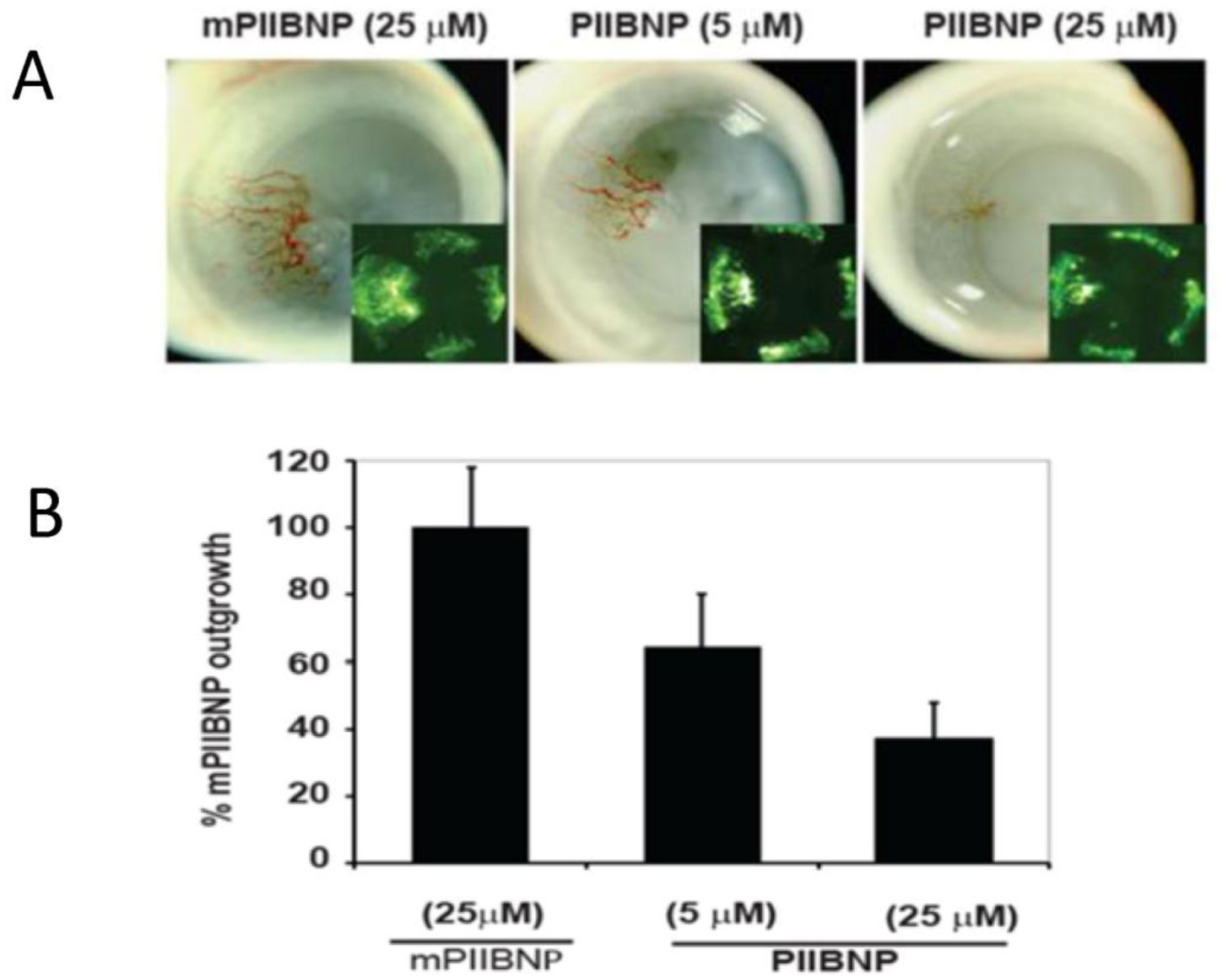Cartilage tissue is avascular and resistant to tumor invasion, but the basis for these properties is still unclear. Here we report that the NH2-propeptide of type IIB procollagen (PIIBNP), a product of collagen biosynthesis, is capable of inhibiting angiogenesis both in vitro and in vivo. PIIBNP inhibits tube formation in human umbilical vein cells (HUVEC), inhibits endogenous endothelial cell outgrowth in mouse aortic ring angiogenesis bioassay and is anti-angiogenic in the mouse cornea angiogenesis assay. As αVß3 and αVß5 integrins are expressed primarily in endothelial cells, cancer cells and osteoclasts, but not in normal chondrocytes and PIIBNP binds to cell surface integrin αVß3 and αVß5, we propose that natural occurring PIIBNP protects cartilage by targeting endothelial cells during chondrogenesis, thus inhibiting angiogenesis, and rendering the tissue avascular.
1.
Introduction
Cartilage is avascular and resistant to tumor invasion. The rationale for lack of vascular and tumor invasion of cartilage has been actively sought for many years [1],[2]. Several possible mechanisms have been proposed, but none have adequately accounted for the lack of vascularity [3],[4]. Fibrillar collagens, types I, II, III, V and XI are biosynthesized as procollagens with both amino and carboxy-terminal globular extension peptides. Type II procollagen has two alternative splice forms of the NH2-propeptide that either contain a cysteine-rich domain (von Willebrand C) encoded by exon 2 (type IIA) or do not contain exon 2 (type IIB) [5],[6]. Most often, the N- and C-terminal peptides of fibrillar collagens are propeptides being removed prior to deposition of the collagen monomers into fibrils in the extracellular matrix. However, in many embryonic tissues, type IIA procollagen retains the NH2-propeptide when deposited into the extracellular matrix [7]. Type IIA procollagen is present in embryonic basement membranes, developing heart, spine and chondroprogenitor cells while type IIB procollagen is synthesized almost exclusively by chondrocytes rendering it the predominant protein in cartilage.
Angiogenesis is the formation of neovessels from preexisting blood vessels. Angiogenic activity is a normal and vital process in growth and development, as well as in wound healing. Angiogenesis is also essential for tumor growth and metastasis [1],[8],[9]. Tumor cells upregulate the production of growth factors such as fibroblast growth factor (FGF) and endothelial cell growth factor (VEGF) in order to stimulate angiogenesis and blood vessel formation. Human body has the ability to produce angiogenesis inhibitors and regulate the amount of blood vessels present at any given time by the checks of balance between stimulators and inhibitors. When the process of angiogenesis is out of balance, it results a myriad of diseases. Excessive angiogenesis leads to Cancer, Blinding diseases [10],[11], Arthritis [12], Endometriosis [13], Multiple sclerosis [14], Alzheimer's disease [15], and Obesity [16]. Several endogenous inhibitors of angiogenesis have been identified including matrix-derived inhibitor endostatin and no-matrix-derived inhibitor chondromodulin-1 [4].
Integrin αVß3 is expressed in high level especially in endothelial cells of granulation tissue and cancer [17]. Pharmacological inhibition of integrin αVß3 suppresses angiogenesis in many experimental models. Many endogenous inhibitors of angiogenesis such as angiostatin, endostatin and tumstatin work through interaction with αvβ3 receptors [18]. We have previously reported that type IIB procollagen.
N-Propeptide, PIIBNP, adheres and kills chondrosarcoma, breast and uterine cancer cells via binding to cell surface integrin αvβ3 and αvβ5 [19]. In vivo, in a tumor model for breast cancer, PIIBNP was consistently able to reduce the size of the tumor [19]. Here we report that PIIBNP not only induces death of tumor cells but also inhibits angiogenesis both in vitro and in vivo.
2.
Experimental procedures
2.1. HUVEC cell migration assay
HUVEC cell migration assay was performed using a 24-well plate with Trans well Permeable Supports. The filter (8 µm pre size, Corning Incorporated, NY) was coated with fibronectin at 20 µg/ml in PBS for overnight at 4°C. 40,000 cells in 0.1 ml of serum-free medium containing 3 µM of control protein GST, RGD containing peptide PIIBNP or PIIBNP mutant mPIIBNP were added into the insert which was then set into the lower chamber containing 0.6 ml of complete medium in a 24-well plate and the plate was incubated at 37°C for overnight. Cloning and expression of PIIBNP and mPIIBNP has been reported previously [19]. The cells in topside of the filter were removed by scribbling twice with cotton tipped swab previously moistened with serum free medium. The migrated cells were fixed with 4% PFA for 10 minutes and stained with 0.5% toluidine for 5 minus. After wash with water, the dye was dissociated with 100 µl of 0.2% SDS solution. Quantification of cells migrated across the membrane was performed by measuring the absorbance at 595 nm.
2.2. Tube formation assay in HUVEC
HUVEC cells obtained from Dr. Williams A. Frazier's laboratory (Department of Biochemistry and Molecular Biophysics, Washington University) were plated in tissue culture dishes previously coated with 0.1% gelatin. The cells were maintained in M199 Earle's Medium with P/S and L-Glutamine supplemented with 10% FBS, 2.5 M Hepes, Heparin, Mitogen and Fungizone. HUVEC cell tube formation assay was performed using a reported method [20] with some modifications. Briefly, a suspension of 75,000 cells in complete medium was seeded in a 24-well plate previously coated with Matrigel and incubated with control peptide GST, recombinant GST fusion peptide PIIBNP or mutant peptide mPIIBNP (0–10 µM). Formation of tubes was evaluated using a light microscope equipped with a Q Capture Pro imaging software. At least 2 (4×) pictures were taken from each treatment and each treatment was triplicated. The branch points of tube formation were counted.
2.3. Aortic ring formation
Angiogenesis was assayed by culturing rings of mouse aorta in three-dimensional Matrigel as reported in the literature [21]. The cultures were kept at 37°C in a humidified environment for a week in the presence of FGF and GST, mPIIBNP, or PIIBNP. The microvessel outgrowth was visualized with a light microscope and digitally photographed with a Q capture Retiga 2000R camera. The microvessels were quantified by measure the percentage of area occupied by the microvessels.
2.4. Mouse corneal microvessel outgrowth assay
Mouse cornea angiogenesis assay was reported in the literature [24]. Briefly, Polymer pellets that contain FGF were prepared and implanted into mouse corneas. The mice received the osmotic pumps containing mutant PIIBNP or PIIBNP. Blood vessel formation was visualized with a dissecting scope and microvessels were visualized by fluorescence microscopy and quantified by Metamorph software.
3.
Results
3.1. PIIBNP inhibits HUVEC cell migration
We have previously reported that PIIBNP binds to cells via ligation to cell surface integrin αvβ3 and αvβ5 and induced death of chondrosarcoma cells (hCh-1), breast cancer cells (MB231) and cervical cancer cells (Hela) [19]. All these cell lines express high level of integrin αvβ3 or/and αvβ5. Endothelial cells also express high level of αvβ3 integrin [17],[25], we hypothesized that PIIBNP could also affect endothelial cell functions. To test this hypothesis, we begin to investigate if PIIBNP affects HUVEC cell migration. HUVEC cell transwell migration in the presence of 2 µM of GST, PIIBNP or mPIIBNP was assayed using a 24-well Transwell permeable supports. As showed in in Figure 1, PIIBNP reduced the number of HUVEC cells crossing the membrane by more than 35% as compared with that in the presence of GST alone. In the presence of mPIIBNP, the number of cells migrating through the membrane is similar as that in the presence of FBS, indicating that mPIIBNP does not inhibit HUVEC cell migration.
3.2. PIIBNP inhibits tube formation in HUVEC cells
In order to determine whether PIIBNP affects angiogenesis, we performed HUVEC cell tube formation assays. HUVEC cells were cultured in 3D Matrigel matrix and incubated with 1 to 10 µM of GST, mPIIPNP or PIIBNP for 22 hours in tissue culture incubator. The tube networks were visualized under light microscope and photographed using a Q capture Retiga 200R camera. PIIBNP, but not mPIIBNP or GST alone, inhibited tube formation in HUVEC cells (Figure 2A). The tube formed was quantified by counting the branch points in each field. The results showed in Figure 2B represent the average of 4 independent measurements. These data indicated that PIIBNP inhibited HUVEC cell tube formation in a dose-dependent manner.
3.3. PIIBNP inhibits microvessel formation in primary endothelial cells
In order to determine whether PIIBNP inhibits angiogenesis in primary endothelial cells, we performed mouse aortic ring formation assays. Small pieces of mouse aorta were cultured in 3-D Matrigel matrix in the presence of FGF and recombinant proteins. The microvessel formation was visualized under light microscope and total length of microvessel outgrowth was measured. Without the presence of FGF, there was no microvessel outgrowth. As shown in Figure 3A, in the presence of 3 µM of GST or mutant PIIBNP (mPIIBNP), microvessel formation was seen. In the presence of 3 µM of PIIBNP, however, microvessel formation was effetely inhibited. The inhibition of FGF stimulated microvessel outgrowth by PIIBNP is in a dose-dependent manner (Figure 3B).
3.4. PIIBNP inhibits angiogenesis in vivo
We have shown that PIIBNP effectively inhibited angiogenesis in vitro. To investigate if PIIBNP also inhibited angiogenesis in vivo, we performed mouse corneal angiogenesis assays. Polymer pellets that contained FGF were prepared and implanted into mouse corneas. The mice were then treated with mPIIBNP or PIIBNP using osmotic pumps. Blood vessel formation was visualized with a dissecting scope and microvessels were quantitated by fluorescence intensity. As shown in Figure 4A, the mutant PIIBNP did not inhibit microvessel formation in the mouse cornea assays, but 5 µM of PIIBNP did (Figure 4A). 25 µM PIIBNP inhibited the microvessel formation by more than 60% as compared with 25 µM of mutated PIIBNP (Figure 4B).
Taken together, the data showed here demonstrated that RGD-containing peptides PIIBNP from cartilage inhibits angiogenesis as indicated by HUVEC tube formation assays, aortic angiogenesis assays and mouse corneal assays.
4.
Discussion
Anti-tumor and avascularity of cartilage have been known for many years, but mechanism behind this is still unknown. In this report, we have shown that the recombinant PIIBNP is able to inhibit angiogenesis both in vitro and in vivo.
Fibrillar type II collagen is biosynthesized as procollagen containing NH2- and COOH-terminal extension peptide called propeptide. Generally, these propeptides are removed prior to deposition of collagen monomers into fibrils in the extracellular matrix [22]. Type IIB procollagen is synthesized by chondrocytes [23] from cartilage, a tissue in which vascular cells are excluded. PIIBNP has a number of unique properties: it is a naturally occurring peptide liberated from the collagen molecule during biosynthesis; it contains vicinal RGD peptides that bind specifically to αVß3 and αVß5-integrins; it kills cells that express these integrins by a mechanism that involve ligation to integrin αvβ3 and αvβ5; and it inhibits angiogenesis. By virtue of its pattern of synthesis, highest during cartilage formation, and its ability to eliminate endothelial cells and osteoclasts from the developing cartilage, it is an excellent candidate for the molecular mechanism by which cartilage remains avascular and intact.










 DownLoad:
DownLoad:






